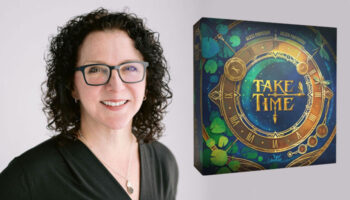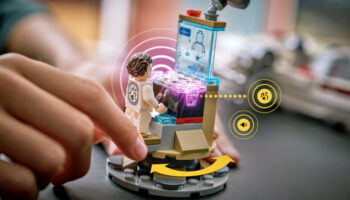The Good Game Company’s Dave Yearick on Fuzzy Logic, Bigfoot Vs Yeti – and his most underrated game

Dave, it’s great to catch up. Let’s start at the beginning… What set you on the road into board games?
Well, every day I feel like I’m brand new at this! But I got into this industry on a whim with two college buddies back in the early Nineties. We invented a board game and our greatest asset was that we had no idea what we were doing! We had heard that the guys who invented Trivial Pursuit went to the same college as us 15 years earlier… We heard they were now buying golf courses and wineries – printing money! We thought: ‘Wow, what a great way to make a living… Let’s make a board game!’
We have Trivial Pursuit to thank!
Exactly! And Trivial Pursuit was the origin of what we now consider adult social games. There’s a lineage from Cards Against Humanity back to Trivial Pursuit. We were playing that game along with everybody else, then Pictionary came out, so we were thinking of ideas for games… Could that be a game? Could that be a game? Then we found our hook: What do these three things have in common? We called the game TriBond… We thought that was a fantastic name, but in hindsight it’s terrible. It sounds like a brand of industrial glue!
Ha! But TriBond was a hit, right?
The stars aligned. It was good timing. Our game was lateral thinking. The question might be: What does a car, a tree and an elephant have in common? They all have trunks. I say that, in the UK cars have boots, right?
They do – but I was with you on trunk! Fun!
If you didn’t know a trivia question, you’d never figure it out. Whereas in TriBond, you could analyse the riddle and work with a teammate to crack it. But yes, it was good timing.

And who did you create TriBond with?
Tim Walsh and Ed Muccini. We were all living in different parts of the country, doing different things and this was a side hustle. We raised money from family and friends and hired a printer to make the game. We wanted the game board to be triangular and I could only find one printer willing to make it – a company named Patch Press. We hired them, and at that time they were printing puzzles for a company that sold into Walmart. By then, our game was on its third print run and Patch saw our game was doing pretty well. So we did a joint deal where they licensed TriBond as their very first game, and with the Walmart relationship they were able to get TriBond placed… Tim went to work for Patch Press, which became Patch Products, which then became PlayMonster! TriBond went on to sell over three million copies.
Amazing. And once TriBond got into Walmart, how long was it before you invented another game?
Well, not long after that, Ron Weingartner – an Inventor Relations guy from Hasbro – reached out and said: “I know we passed on TriBond, but what else do you have?” And I didn’t have anything else! That’s when I realised I should come up with some new ideas… So I started pitching games as a freelance inventor. And I remember, Ron said to me: “I don’t like any of these games, but you’ve got what it takes. Stick at it!” So I have him to blame – or thank! I don’t know! He actually licensed a game from me.
Ah, which one?
It was called Bamboozle. It launched in 1997 and sold for one year. The timing was poor because it was around the time when Milton Bradley and Parker Brothers merged. Milton Bradley had Taboo and Parker Brothers had Catchphrase… Bamboozle was a similar clue-giving word-guessing game. But Bamboozle has since become a game in our catalogue called Second Thoughts.

Amazing. But back around that time – 1997 – you weren’t inventing full-time?
No. I owned retail clothing stores. But when I saw that my real career was losing me money and my side-hustle was making me money, I embraced inventing. And I was a freelance inventor for many years…
What inspired you to leave inventing and go back to self-publishing?
As an inventor I’d had some success and I’d had some frustrations – and I became aware that it’s very hard to invent an evergreen. I looked back and realised that I had the most success when I brought something to market myself. That’s also what I enjoyed the most.
So I looked at all of my rejected items, and one stood out – a throw and catch item called SlingBall. I’d pitched it 25 times, and around 20 of those times it had been taken in by the company – who’d then eventually pass on it. I was a bit burnt out on games, and although it was a higher investment to tool up than a game, I chose SlingBall as the next item to create and sell myself. This line then grew to have several skus in the outdoor sport-toy category under the brand name Djubi.

At Toy Fair in 2016, Blue Orange approached me about doing something with it. I liked them and we embarked on a distribution partnership. Having them on board then freed up some time for me. I had a game called Idiom Addict that I’d licensed to Marbles The Brain Store. By chance, the license was over around the same time so I got the game back. That’s when I decided to self-produce it and a couple of other games, and I created my own games company: The Good Game Company.
And when was this Dave?
The Good Game Company’s first Toy Fair was 2020 – right before the pandemic. Prior to that I was selling on amazon and at Barnes and Noble. Since then, we’ve grown to around 20 skus. To come full circle, the Djubi distribution contract with Blue Orange ended this year and I’m bringing that into our line. It was a difficult decision because Blue Orange has been great and they’ve always been proud to carry the line in their catalogue, but we’ve now brought that range in-house and as such, we’ve almost doubled in size.
And is The Good Game Company just you Dave, or do you have a team?
It was just me, then I hired my son Rudiger as Marketing Manager and in February I hired Kyle Cosgrove to be National Sales Manager. But it’s all very holistic; we help each other in all aspects of R&D, sales and marketing. People think we’re much bigger than we are, which I guess is a complement!
Let’s dive into your games, starting with Fuzzy Logic. How did this one come about?
I started with the win condition: You win by guessing the most words. And I had a title in mind: Kinda, Sorta, Maybe. So that suggests a guessing game where you’ve got to be careful about the clues you give. That evolved into Fuzzy Logic, where you’ve got to give clues about your word, without leading your team to guess your opposing team’s word.

So my team’s word is ‘Lemon’. The other team’s word is Banana. I have to give clues that will lead my team to guess ‘Lemon’, without accidentally leading them to ‘Banana’… So ‘fruit’ and ‘yellow’ would be risky!
Exactly! My friend called it: ‘Codenames meets Password’. What a great compliment!
A great compliment and a good way to pitch the game. Is Fuzzy Logic indicative of the kinds of games you like to create?
Absolutely. Quick, simple… A great title and packaging that’s alluring. Look at Chunky Monkey Business – the title is a riddle you’d find in the game. You have ‘Chunky _____’ and ‘_____ Business’. You get the start and the end of a riddle, and you have to find the word that ties them together – in this case, ‘Monkey’. You can explain it in a heartbeat and get playing right away.

And you’re also launching your first co-operative game soon too?
Yes – Beat the System. It takes the generic game of Fishbowl – where the first round you can say anything, the second round you can mime and the third round you can say one word – but in our game you’re playing against the game. When I first heard about co-op games I arrogantly thought: ‘No, you’ve got to have a winner and a loser… Everyone can’t win!’ But when you see adults really pull together to beat the box, you can’t deny it. It is being launched as a Barnes & Noble exclusive, hitting shelves this week!
Great! Are these all in-house designs or do you work with external inventors?
So far, our whole catalogue is made up of my games. We haven’t taken on inventor items yet, but I do plan to! I want to start collaborating with inventors and I have a soft spot for them, because that’s what I am really. In due time I want to make that a big part of what we do and hopefully that’ll include engaging with your infrastructure; being at the Mojo Pitch on the other side of the table.
We’d love to get you involved Dave – keep us posted! I also wanted to ask about another of your recent launches, Bigfoot Vs Yeti: Splat Attack. Was this a kind of evolution of Cowpie Catapults?
Yes, the original prototype I created was actually a SpongeBob game. It was a SpongeBob Krabby Patty Food Fight game that I invented 15 years ago! Both Hasbro and Mattel looked at it over the years when they had the SpongeBob licence, but they returned it. It had rubber Patty burgers, the catapults were spatulas and you were knocking the characters over. So anyway, one day I was in my archive room and I took that game back out. I felt it was a good game, I just needed to work out what it could be… And it became Cowpie Catapults. That was our number one seller in units sold last year.

Amazing!
We sold to a lot of farm and tractor stores! Theme is important and it got us into a lot of stores we wouldn’t have sold our word games into. We have a dice and card game called Not It! that we’ve reskinned in different themes, and so I started to look at what else we could do with Cowpie Catapults…
How did you land at yetis and Bigfoot?
I was at the IGES show in Pigeon Forge, Tennessee. It’s where you sell to a lot of souvenir stores and gift shops. While I was there, I noticed there was a lot of Bigfoot stuff out… It was like Bigfoot had just been invented! So that sparked the idea for Bigfoot throwing mud…
No yetis at this point?
No – Bigfoot Vs Bigfoot! And this is how silly my brain is… I then went into a bit of trance thinking: ‘Well, what if it was Bigfoot Vs Yeti… No, that’d never work… Bigfoot and Yeti don’t live in the same place.” I had that actual argument with myself – and had to convince myself it would work!
Ha! And it has!
Yes, we introduced it at Toy Fair last year and we’re excited to say it’s on Target shelves as we speak! It’s doing really well – it’s our number one seller across the board, from specialty to mid-tier to mass. There certainly have been other catapult games, but the thing I’m proud of with ours is the projectiles. They’re rubbery and they splat well. They don’t roll off the table.
There it is in action. Now, let’s go back to Not It! Tell me about this one.
Yes! Well at its core, it’s a fast-paced dice-and-card game that inverts classic mechanic of matching features, which leads to plenty of comical mistakes since the game itself demands so much quick-thinking.
What I love most about it is that it’s just as entertaining for those who are seven and 70. It’s also packaged inside a functional dice tower, which gives it such a unique shelf presence that customers have really responded well to… We’ve heard from many Not It! fans that playing the game was actually their first introduction to the entire concept of a dice tower!

Fantastic. Before we wrap up, what has been your most underrated game? We can give it some love here!
I’d say my family’s favourite game – Second Thoughts; the game I licensed to Hasbro as Bamboozle. It’s a game where each teams writes down five words on their word slate, each using a letter determined by the roll of a dice. Teams then swap slates and have to give clues to their teammates in a bid to guess as many of the words as possible.

So you want to try and write tough words to make the other team’s life difficult.
Yes, but the amount of time it takes you to create your list of words is the amount of time the opposing team have to guess the words. So the longer you take to write tough words, the longer the other team have to guess them.
Terrific idea.
The people that play the game, love it – but it’s not the easiest game to explain. I don’t know if you’ve truly understood it and I’ve taken two minutes trying to explain it!
Ha! I’ll pop a video of it in action here to leave people in no doubt of how it plays.
If I’m at a trade show demoing it, it takes a while for folks to get the ‘aha’ moment. People want to grasp games quick, so that’s been its downfall. We’re actually developing a new word guessing game that’s unique and very easy to explain, so we might retire Second Thoughts… We can’t have everything in our catalogue… If we do, I’ll always have a soft spot for it.
Dave, this has been fun! Huge thanks again.
–
To stay in the loop with the latest news, interviews and features from the world of toy and game design, sign up to our weekly newsletter here




















